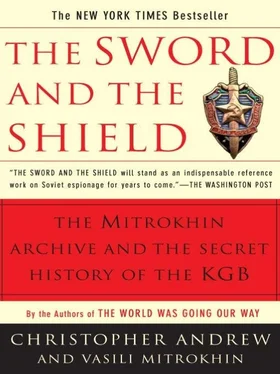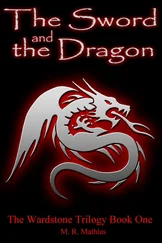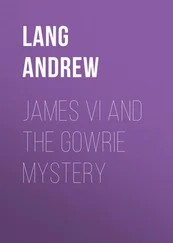The centerpiece of the active measure against Howard Hunt, codenamed ARLINGTON, was a forged letter to him from Oswald, allegedly written a fortnight before the assassination. The letter used phrases and expressions taken from actual letters written by Oswald during his two years in the Soviet Union, was fabricated in a clever imitation of his handwriting.
Dear Mr. Hunt,
I would like information concerning my position.
I am only asking for information. I am suggesting that we discuss the matter fully before any steps are taken by me or anyone else.
Thank-you.
Lee Harvey Oswald 34
The implication, clearly, was that Oswald wanted to meet Hunt before going ahead with the assassination.
Before being used, the forgery was twice checked for “authenticity” by the Third Department of the KGB’s OTU (operational technical) Directorate. In 1975 photocopies of it were sent to three of the most active conspiracy buffs, together with covering letters from an anonymous wellwisher who claimed that he had given the original to the Director of the FBI, Clarence Kelly, who appeared to be suppressing it. The Centre was doubtless disappointed that for almost two years its forgery received no publicity. In 1977, however, the letter was published by Penn Jones, the retired owner of a small Texas newspaper and self-published author of four books about the assassination. The New York Times reported that three handwriting experts had authenticated the letter. Oswald’s widow also identified her husband’s handwriting. 35Experts summoned by the House Select Committee on Assassinations in 1978 concluded more prudently that they were unable to reach a “firm conclusion” because of the absence of the original document. 36
The Centre was somewhat put out, however, by the fact that initial press reaction to its forgery centered chiefly on the likelihood of the letter being addressed to the late Texan oil millionaire H. L. Hunt (the central character in its own original conspiracy theory), rather than the KGB’s current intended target, the Watergate conspirator Howard Hunt. Service A believed there had been a CIA plot to disrupt its own plot. The KGB reported that an “orchestrated” American press campaign was seeking to divert public attention from Oswald’s connections with the American intelligence community by concentrating on H. L. Hunt instead. In April 1977, soon after the publication of the forged letter, the KGB informed the Central Committee that it was launching additional active measures to expose the supposed role of the “American special services” in the Kennedy assassination. 37By 1980 Howard Hunt was complaining that, “It’s become an article of faith that I had some role in the Kennedy assassination.” 38
By the late 1970s the KGB could fairly claim that far more Americans believed some version of its own conspiracy theory of the Kennedy assassination, involving a right-wing plot and the US intelligence community, than still accepted the main findings of the Warren Commission. Soviet active measures, however, had done less to influence American opinion than the Centre believed. By their initial cover-ups the CIA and the FBI had unwittingly probably done more than the KGB to encourage the sometimes obsessional conspiracy theorists who swarmed around the complex and confusing evidence on the assassination. Allen Dulles, the recently retired DCI on the Warren Commission, had deliberately not informed the commission that the CIA had plotted the assassination of Castro. On the very day of Kennedy’s assassination, the Agency had supplied an agent with a murder weapon for use against Castro. J. Edgar Hoover too had held back important information. He discovered, to his horror, that Oswald had not been included on the FBI’s security index of potentially disloyal citizens, despite having written a threatening letter to the Bureau after his return from Russia and subsequently making an appointment to see a KGB officer in Mexico City. After reading a report on “investigative deficiencies in the Oswald case,” Hoover concluded that, if it became public, the report would destroy the FBI’s reputation. 39
The information withheld by Dulles and Hoover would have been most unlikely to undermine the Warren Commission’s conclusion that Oswald had been a lone assassin. But, when it became public in the mid-1970s, it inevitably encouraged the belief that there had been other cover-ups which pointed to the involvement of the intelligence community. The Watergate scandal, and the revelations of intelligence abuses which followed, created a perfect breeding ground for the spread of conspiracy theories. 40Though most of the major abuses had been ordered or authorized by successive presidents, the belief grew that, in the words of Senator Frank Church, chairman of the Senate Select Committee to Study Governmental Operations with Respect to Intelligence Activities, the CIA had been “behaving like a rogue elephant on the rampage.” 41
SERVICE A SEIZED eagerly on Church’s ill-chosen metaphor. The KGB’s most valuable asset in its active measures to discredit the Agency was an embittered former CIA operations officer in Latin America, Philip Agee (codenamed PONT), 42who had been forced to resign in 1968 after complaints at his heavy drinking, poor financial management and attempts to proposition wives of American diplomats. 43Though he remained in the West, Agee became, in effect, the CIA’s first defector. In 1973 he approached the KGB residency in Mexico City and offered what the head of the FCD’s Counter-intelligence Directorate, Oleg Kalugin, called “reams of information about CIA operations.” The suspicious KGB resident, however, found Agee’s offer too good to be true, concluded that he was part of a CIA plot and turned him away. According to Kalugin:
Agee then went to the Cubans, who welcomed him with open arms… The Cubans shared Agee’s information with us. But as I sat in my office in Moscow reading reports about the growing list of revelations coming from Agee, I cursed our officers for turning away such a prize. 44
In January 1975 Agee published an uncompromisingly hostile memoir of his career in the CIA entitled Inside the Company: CIA Diary, which identified approximately 250 Agency officers and agents and claimed that “millions of people all over the world had been killed or had their lives destroyed by the CIA and the institutions it supports.” 45The self-congratulatory KGB file on the book claims, doubtless with some exaggeration, that it was “prepared by Service A, together with the Cubans.” 46Mitrokhin’s notes do not indicate exactly what the KGB and its Cuban ally, the DGI, contributed to Agee’s text. As Agee himself acknowledged, however: “Representatives of the Communist Party of Cuba [the DGI]… gave important encouragement at a time when I doubted that I would be able to find the additional information I needed.” 47While Agee was writing his book in Britain, the KGB maintained contact with him through its co-optee, Edgar Anatolyevich Cheporov, London correspondent of the Novosti news agency and the Literaturnaya Gazeta. 48At Service A’s insistence, Agee removed all references to CIA penetration of Latin American Communist parties from his typescript before publication. 49
Because of legal problems in the United States, Inside the Company was first published in Britain, where it was an instant bestseller. The London Evening News called it “a frightening picture of corruption, pressure, assassination and conspiracy.” The Economist commended it as “inescapable reading.” Probably most valuable of all, from Service A’s viewpoint, was a review in the Spectator by Miles Copeland, a former CIA station chief in Cairo, who described Inside the Company as “as complete an account of spy work as is likely to be published anywhere.” With enthusiastic support from a number of journalists, Agee then set about unmasking the members of the CIA London station, some of whom were surprised emerging from their homes by press photographers. An American theater director staged a production satirizing the Agency in front of a number of CIA officers’ houses. “For a while,” claimed Agee, “the CIA in Britain was a laughing stock.” The left-wing Labor MP Stan Newens promoted a Commons bill, signed by thirty-two of his colleagues, calling for the CIA station to be expelled. Encouraged by Agee’s success in Britain, there was a rush by the media in other parts of Europe to expose the CIA stations in their own capitals. 50
Читать дальше











